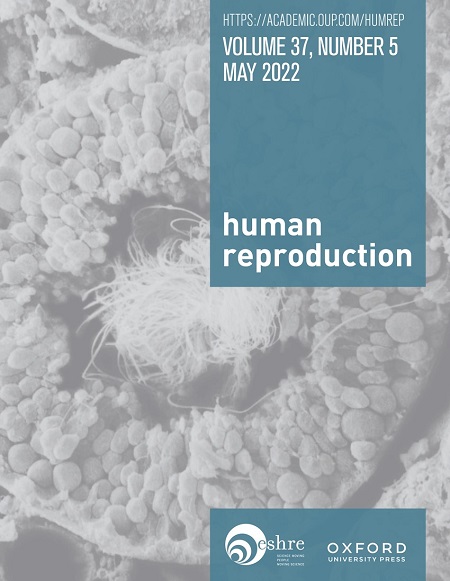A video clip detailing the patient journey on the day of oocyte retrieval in addition to the standard of care: a randomized controlled trial
IF 6
1区 医学
Q1 OBSTETRICS & GYNECOLOGY
引用次数: 0
Abstract
STUDY QUESTION Can a video clip detailing the patient journey decrease women’s anxiety on the day of their first oocyte retrieval? SUMMARY ANSWER The video clip does not affect women’s anxiety on the day of their first oocyte retrieval. WHAT IS KNOWN ALREADY IVF triggers anxious reactions in women and men, with peaks of anxiety on the day of (especially the first) oocyte retrieval as shown by reliable questionnaires and biomarkers of distress. Several trials showed that videos with preparatory information reduce women’s and men’s anxiety for out-patient procedures. STUDY DESIGN, SIZE, DURATION This monocentric open-label randomized controlled trial (RCT) randomized (computerized 1:1 allocation) 190 heterosexual couples about to start their first IVF cycle during a 24 months’ recruitment period (2018–2020). In addition to the standard of care offered to both the intervention group and the control group, the intervention group received a video clip, the day prior to their first oocyte retrieval, detailing the patient journey on the day of oocyte retrieval. After completion of the RCT, 35 additional couples were recruited as part of a qualitative process evaluation (QPE). PARTICIPANTS/MATERIALS, SETTING, METHODS Upon arrival at a private secondary care fertility centre in Belgium for their first oocyte retrieval, women and men independently filled out the State module of the ‘State-Trait Anxiety Inventory’ (STAI) and the ‘Infertility-Specific Distress Scale’ (IDS) and evaluated the novel intervention, if applicable. In addition, clinical and discontinuation outcomes were extracted from couples’ electronic medical records 24 months later. The data of 155 couples (76–79/group) were subjected to an intention-to-treat analysis. The 35 couples taking part in the QPE filled out two questionnaires assessing knowledge and, if applicable, took part in an in-depth interview on their experience watching the video clip, immediately before their first oocyte retrieval. MAIN RESULTS AND THE ROLE OF CHANCE The video clip did not affect women’s anxiety on the day of oocyte retrieval (mean STAI-State score intervention group = 42.7 ± 8.1 vs control group = 42.1 ± 8.5, P = 0.68). Men who watched the video clip were, however, significantly less anxious than men who did not watch it (35.8 (±6.4) vs 38.2 (±7.6), P = 0.034). Surprisingly, infertility-specific distress was higher among women and men who watched the video clip, as compared to women and men who did not watch the video clip (mean Infertility-specific Distress (IDS) scale score for women, 25.8 (±4.9) vs 24.3 (±4.6), P = 0.051; men, 22.6 (±5.0) vs 20.8 (±4.7), P = 0.023). The QPE clarified that watching the video clip did not increase knowledge about what would happen but that some women and men found the visualization of invasive procedural steps more confrontational than the earlier received, abstract, written, and verbal information. All but one woman and all men in the intervention group would recommend the video clip to friends and family going through IVF. The intervention and control groups did not differ regarding secondary clinical and discontinuation outcomes. LIMITATIONS, REASONS FOR CAUTION Due to the nature of the intervention it was not possible to blind the participants. Furthermore, we did not have an attention control group, which could have separated plausible benefits of the intervention from attentional effects, although limiting performance bias in educational intervention studies is difficult as study personnel cannot be blinded. Of note, this RCT was partially conducted during the COVID-19 pandemic; thus, postponement of the oocyte retrieval and plausible side effects of the pandemic itself might have impacted our results, but group differences are corrected by the randomized controlled design of our trial. WIDER IMPLICATIONS OF THE FINDINGS Providing additional procedural information is interesting for clinics as patients recommended the video clip and as it decreased men’s anxiety on the day of couples’ first oocyte retrieval. The effect of the intervention was observed in a Dutch-speaking population, and investigating beneficial effects of the video clip in non-native speakers and patients with a lower education or literacy level may be of interest, as they are more prone to health information overload and often benefit from visual rather than verbal or written information. STUDY FUNDING/COMPETING INTEREST(S) This research was supported by the Research Council of the KU Leuven (C14/18/106; project of J.V., K.P., and E.A.F.D.) and it is an Investigator Sponsored Study for Merck N.V./S.A., an affiliate of Merck KGaA, Darmstadt, Germany. Merck N.V./S.A. had no ultimate authority nor any other role in the design, data collection, data management, data analysis, data processing, data interpretation, and on the decision to submit this study for publication. T.M.D. is vice president and Head of Global Medicine Affairs Fertility, Research and Development, Merck Healthcare KGaA, Darmstadt, Germany. He is also a visiting professor in Reproductive Medicine and Biology at KU Leuven, Belgium and an adjunct professor at the Department of Obstetrics and Gynecology at the University of Yale, New Haven, USA. Neither his corporate role nor his academic roles represent a conflict of interest with respect to the work done by him for this study. The other co-authors have no conflict of interest. TRIAL REGISTRATION NUMBER This trial is registered at clinicaltrials.gov as NCT03717805. TRIAL REGISTRATION DATE 10 October 2018 DATE OF FIRST PATIENT’S ENROLMENT 29 October 2018除标准护理外,一段详细描述患者卵母细胞提取当天旅程的视频剪辑:一项随机对照试验
研究问题:一段详细描述患者旅程的视频片段能否减少女性在第一次取卵当天的焦虑?视频片段不会影响女性在第一次取卵当天的焦虑。试管受精会引发女性和男性的焦虑反应,根据可靠的问卷调查和焦虑的生物标志物显示,焦虑在取卵当天(尤其是第一天)达到顶峰。几项试验表明,带有准备信息的视频可以减少女性和男性对门诊手术的焦虑。研究设计、规模、持续时间这项单中心开放标签随机对照试验(RCT)随机(计算机1:1分配)190对异性恋夫妇,他们将在2018-2020年的24个月招募期内开始第一个试管婴儿周期。除了为干预组和对照组提供的标准护理外,干预组在第一次取卵前一天还收到了一段视频剪辑,详细介绍了患者在取卵当天的旅程。RCT完成后,又招募了35对夫妇作为定性过程评估(QPE)的一部分。参与者/材料,环境,方法抵达比利时一家私人二级生育护理中心进行第一次卵母细胞提取时,女性和男性分别填写了“状态-特质焦虑量表”(STAI)和“不育特异性痛苦量表”(IDS)的状态模块,并评估了新的干预措施(如果适用)。此外,从夫妇24个月后的电子医疗记录中提取临床和停药结果。对155对夫妇(76-79对/组)的数据进行意向治疗分析。参加QPE的35对夫妇填写了两份评估知识的问卷,如果适用的话,在他们第一次取卵之前,他们还就观看视频片段的经历进行了深入的采访。视频剪辑对提取卵母细胞当天女性的焦虑无影响(干预组平均STAI-State评分= 42.7±8.1 vs对照组= 42.1±8.5,P = 0.68)。然而,观看视频片段的男性的焦虑程度明显低于没有观看视频的男性(35.8(±6.4)vs 38.2(±7.6),P = 0.034)。令人惊讶的是,与没有观看视频片段的女性和男性相比,观看视频片段的女性和男性的不孕症特异性痛苦更高(女性的不孕症特异性痛苦(IDS)量表平均得分,25.8(±4.9)比24.3(±4.6),P = 0.051;男性,22.6(±5.0)vs 20.8(±4.7),P = 0.023)。QPE澄清说,观看视频片段并没有增加对将要发生的事情的了解,但一些女性和男性发现,可视化的侵入性程序步骤比之前收到的抽象、书面和口头信息更具对对性。除了一名女性和所有干预组的男性外,所有人都会向正在进行体外受精的朋友和家人推荐这段视频。干预组和对照组在继发性临床和停药结局方面没有差异。限制,谨慎的原因由于干预的性质,不可能使参与者失明。此外,我们没有一个注意力控制组,尽管限制教育干预研究中的表现偏差是困难的,因为研究人员不能盲化。值得注意的是,该随机对照试验部分是在COVID-19大流行期间进行的;因此,推迟卵母细胞提取和大流行本身可能的副作用可能影响了我们的结果,但我们试验的随机对照设计纠正了组间差异。研究结果的更广泛意义对于诊所来说,提供额外的程序信息是有趣的,因为患者推荐了视频片段,因为它减少了男性在夫妇第一次取卵当天的焦虑。干预的效果是在说荷兰语的人群中观察到的,调查视频片段对非母语人士和受教育程度或文化水平较低的患者的有益影响可能会引起人们的兴趣,因为他们更容易接受健康信息过载,往往受益于视觉而不是口头或书面信息。研究经费/竞争利益(S)本研究由鲁汶大学研究委员会资助(C14/18/106;j.v., k.p.和E.A.F.D.的项目),它是默克公司的一项研究者赞助研究该公司是默克公司(Merck KGaA)的子公司,位于德国达姆施塔特。默克喷嘴速度/ S.A.在设计、数据收集、数据管理、数据分析、数据处理、数据解释和决定提交本研究发表方面没有最终权力或任何其他作用。T.M.D. 她是德国达姆施塔特默克医疗保健公司(Merck Healthcare KGaA)的副总裁兼全球医学事务、生育、研究与发展主管。他也是比利时鲁汶大学生殖医学和生物学的客座教授,以及美国耶鲁大学纽黑文分校妇产科的兼职教授。他的企业角色和学术角色都不代表他在本研究中所做的工作存在利益冲突。其他共同作者没有利益冲突。该试验在clinicaltrials.gov上注册为NCT03717805。试验注册日期2018年10月10日第一位患者入组日期2018年10月29日
本文章由计算机程序翻译,如有差异,请以英文原文为准。
求助全文
约1分钟内获得全文
求助全文
来源期刊

Human reproduction
医学-妇产科学
CiteScore
10.90
自引率
6.60%
发文量
1369
审稿时长
1 months
期刊介绍:
Human Reproduction features full-length, peer-reviewed papers reporting original research, concise clinical case reports, as well as opinions and debates on topical issues.
Papers published cover the clinical science and medical aspects of reproductive physiology, pathology and endocrinology; including andrology, gonad function, gametogenesis, fertilization, embryo development, implantation, early pregnancy, genetics, genetic diagnosis, oncology, infectious disease, surgery, contraception, infertility treatment, psychology, ethics and social issues.
 求助内容:
求助内容: 应助结果提醒方式:
应助结果提醒方式:


